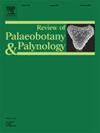First endocarp record of Miquelia (Icacinaceae) from the late Miocene of northern Vietnam and its phytogeographical and paleoecological implications
IF 1.7
3区 地球科学
Q2 PALEONTOLOGY
引用次数: 0
Abstract
Abundant fossil records of Icacinaceae have been documented in the Northern Hemisphere; however, they are rare in the paleotropics where the family is most diverse today. As such, the evolutionary history of the family remains incomplete. In this study, we describe a newly discovered endocarp of Icacinaceae from the late Miocene of northern Vietnam, namely Miquelia yenbaiensis N.B. Hung, J. Huang & S.F. Li sp. nov. The identification is based on detailed morphological observations conducted using a reflected light microscope, together with extensive comparisons with both modern and fossil endocarps of the Phytocreneae. Miquelia yenbaiensis is characterized by sharp, thin, and reticulate ridges, with five main longitudinal ridges, and primarily circular pits arranged in longitudinal lines, with approximately 110–120 pits per face. The fossil examined in our study represents the first fossil record of Miquelia, indicating that this genus existed in northern Vietnam since at least the late Miocene. Additionally, our fossil finding provides the most recent fossil record of the Phytocreneae as well as the Icacinaceae, extending their historical range into tropical Asia during the late Miocene. Miquelia yenbaiensis likely inhabited a wet tropical ecosystem with a multi-stratified forest in the Yen Bai Basin during the late Miocene.
越南北部晚中新世山菖蒲科首次内壳记录及其植物地理和古生态意义
在北半球有丰富的伊卡奇科化石记录;然而,它们在古热带地区是罕见的,而今天这个家族是最多样化的。因此,家族的进化史仍然不完整。在本研究中,我们描述了一种新发现的来自越南北部晚中新世的Icacinaceae内鲤鱼,即Miquelia yenbaiensis N.B. Hung, J. Huang &;利用反射光显微镜对其进行了详细的形态学观察,并与现代和化石的内腕类进行了广泛的比较。延白密荷脊尖而细,呈网状,纵向有5个主脊,以纵向排列的圆形凹坑为主,每面约有110 ~ 120个凹坑。我们研究的化石代表了Miquelia的第一个化石记录,表明该属至少在中新世晚期就存在于越南北部。此外,我们的化石发现提供了植物科和伊卡辛科的最新化石记录,将它们的历史范围扩展到中新世晚期的热带亚洲。延白密枝可能在晚中新世生活在延白盆地具有多层森林的潮湿热带生态系统中。
本文章由计算机程序翻译,如有差异,请以英文原文为准。
求助全文
约1分钟内获得全文
求助全文
来源期刊
CiteScore
3.50
自引率
21.10%
发文量
149
审稿时长
6 months
期刊介绍:
The Review of Palaeobotany and Palynology is an international journal for articles in all fields of palaeobotany and palynology dealing with all groups, ranging from marine palynomorphs to higher land plants. Original contributions and comprehensive review papers should appeal to an international audience. Typical topics include but are not restricted to systematics, evolution, palaeobiology, palaeoecology, biostratigraphy, biochronology, palaeoclimatology, paleogeography, taphonomy, palaeoenvironmental reconstructions, vegetation history, and practical applications of palaeobotany and palynology, e.g. in coal and petroleum geology and archaeology. The journal especially encourages the publication of articles in which palaeobotany and palynology are applied for solving fundamental geological and biological problems as well as innovative and interdisciplinary approaches.

 求助内容:
求助内容: 应助结果提醒方式:
应助结果提醒方式:


